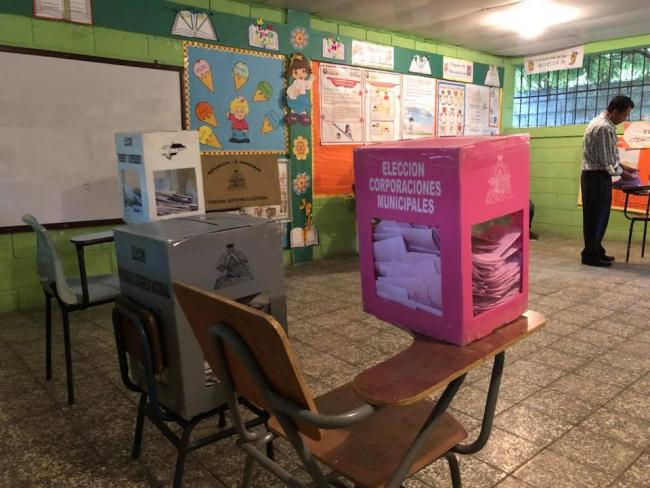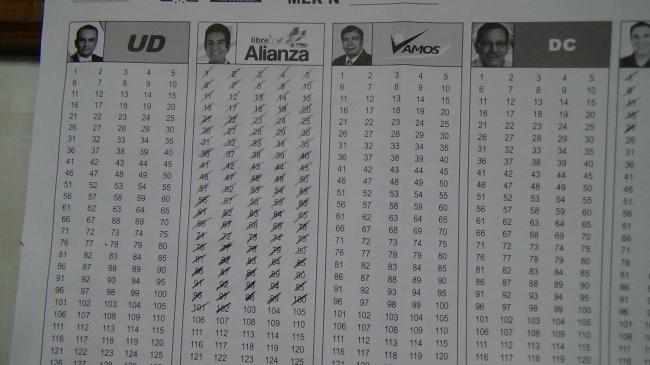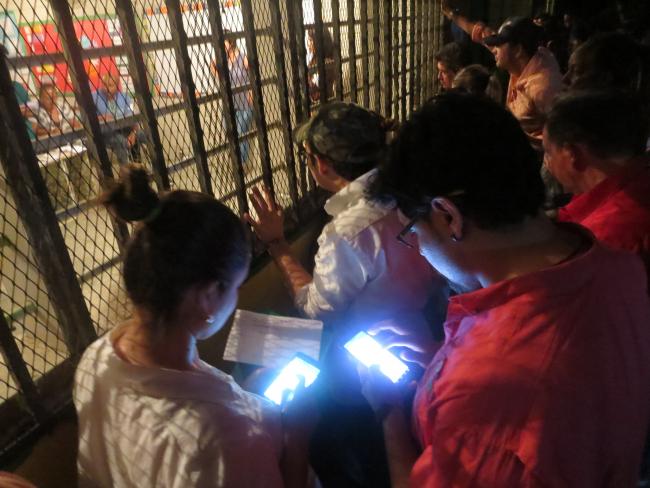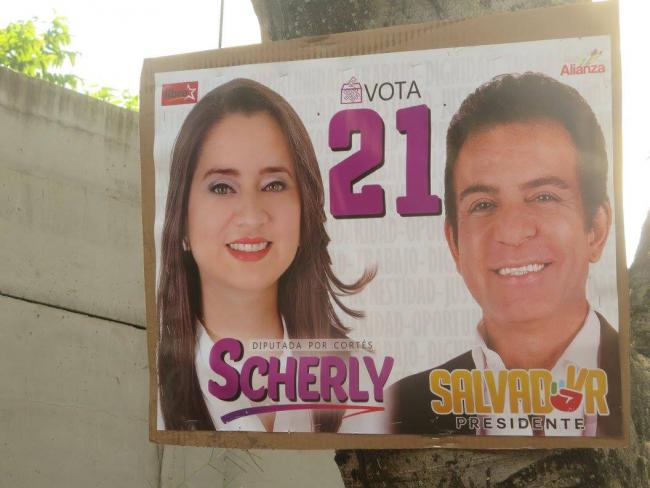Clare Fuget and Alex Brown-Whalen also contributed reporting.

The sounds of pots and pans and other home-made noisemakers permeated the Tegucigalpa night sky on Friday, December 1 as thousands of Hondurans participated in the #CazerolazoNacional2017, defying a 6 PM to 6 AM curfew imposed by the military to stifle dissent in the wake of the country’s presidential elections. The crowd had come to protest the lack of transparency of the Supreme Electoral Tribunal (TSE), which continues to hold election results hostage over two weeks after the elections, presumably to favor the National Party candidate, Juan Orlando Hernández.
With no results in sight, Hondurans are wagering their life and future, resisting a repressive and opaque government, the military, its curfew, and it scare tactics. On December 1, the noise lasted from 10 PM until well past 1 AM in protest of the curfew, itself an abrogation of constitutional guarantees, reminiscent of tactics used to enforce the coup d'etat that ousted democratically-elected President Manuel Zelaya Rosales in 2009. Undaunted, the Honduran people refuse to be diminished, and have taken the streets to challenge the current pseudo-dictatorship and an incompetent TSE magistrate with creative forms of protest, bold use of social media, and even a touch of idiosyncratic Honduran humor.
I served as an international observer during the nation’s elections on Sunday, November 26, along with a group of my students from Pitzer College. Our goal was to document how elections work in Honduras amid a prolonged political crisis that has characterized the country since the 2009 coup. As observers, we were also there to monitor a fair election process. In the southwest sectors of San Pedro Sula, where the most embattled barrios experience some of the highest incidences of violence in the world, we witnessed national elections among 10 main contenders for the presidency, with the incumbent president, Juan Orlando Hernández of the right-wing Nationalist Party and Salvador Nasralla as the top contenders. Nasralla is a former sportscaster-turned-politician from the Alliance Against the Dictatorship, a coalition of the Liberty and Refoundation Party (LIBRE), the Anti-Corruption Party (PAC), and the Innovation and Unity Party (PINU), along with other smaller parties formed after the 2009 coup. We saw an engaged populace that exercised their suffrage rights peacefully and dutifully, and felt viscerally the emotion and effervescence of the voting public, which erupted again, albeit in a different way, at the #CazerolazoNacional2017 just days later.
Voting precincts in Honduras are housed in public schools and are mostly organized by volunteers from each neighborhood, often party activists, who ensure polling places are open and equipped for the proceedings. According to law, polls were to be open from 7 AM to 5 PM. Each of the 13 schools we visited was set up with between four to 58 ballot boxes on voting tables. A secretary, a person assigned to verify voters’ identity cards, and a counter managed each table. Each table is also allowed one representative from each of the parties on the ballot. But smaller parties often do not have enough representatives to cover all the tables in a city. Consequently, party credentials issued by the TSE are often traded and sold on the black market, or party activists may sit at a table using another party’s credential. TSE observers are present throughout the process, primarily to answer questions when disputes arise, often by interpreting the official booklet provided at the polling place. Each party is responsible for training their observers in preparation for the election, while the TSE may provide minimal training to their representatives.
The procedures for handling election materials—opening the booklets that hold the ballots, tearing out the ballots, handing ballots to voters, etc.—are matters of process and ceremony, including various steps to check the voter’s identity, with plenty of stamping and signing characteristic of Honduran bureaucracy. The folding and stamping of the completed ballots, before voters deposit their ballots into ballot boxes, is equally ceremonious. Other and subsequent loose and irregular procedures, like liberal duplication of materials, which we witnessed in this election, easily undermine such formality.
The counts begin once the TSE announces that the voting precincts are closed. This year, all 13 precincts we attended closed at 4 PM, an hour earlier than designated closing times. Since the 2013 elections, voters have gathered at polling stations to observe the count, demanding the table secretary sing out (cantar) individual results. Two recorders add up the votes, one-by-one on two different tally sheets, one of which they fax to the TSE that evening. After the counting is complete, the table representatives pack up everything, including leftover ballots and any other papers into the original boxes. Upon receiving the faxed documents, TSE representatives turn the boxes over to the military to transport to the TSE in Tegucigalpa. At this point, all the people present at each of the tables, including those from all political parties, receive a copy of the legal sized paper tally sheet (acta), which bears the table number and tallies for each candidate from each of the parties written in ink. These actas feature heavily in current disputes about the elections, because the tally sheets should be faxed to the TSE and appear online.
It bears mentioning in all of this that all of the precinct workers are volunteers. Many of them are passionate about their own parties, and many others show up because they see it as their civic duty. Unfortunately, irregularities in the process were still apparent.

National Party Scare Tactics on Election Day
Throughout election day, we witnessed jubilant participation in a democratic and peaceful electoral process with a high participation rate despite heavy militarization in all of the voting precincts. After proclaimed fraud in the 2013 elections, many people anticipated similar inconsistencies in this year’s elections. Hernández’s move to override the Honduran constitution through permission from the Supreme Court in order to run again confirmed these suspicions.
We hear about significant inconsistencies: heavy polling is occurring outside the precincts; National Party activists are buying voting table credentials from other parties to ensure access to tally sheets; the polls are closing early; votes are being bought outright. Some voters we spoke with stated they had been offered 500 lempiras ($21.50 USD) for their votes outside the voting centers. We witnessed the illegal and unconstitutional presence of heavily-armed military police and anti-riot personnel at voting precincts.
We observed such activities in almost all of the 13 precincts we visited. At a school in the Barrio Cabañas of San Pedro Sula, National Party members loitered in different voting stations, speaking with people inside the classrooms where the voting was taking place. Though electronic devices were prohibited from voting sites, many had walkie-talkies to communicate with each other. Military police officers were scattered throughout the school, but made little or no effort to prevent unauthorized people from entering the voting centers. They did, however, scrutinize us—clearly identified and accredited international observers—by inspecting our persons and belongings without asking permission. Toward the end of the night in this particular school—the largest precinct in San Pedro Sula, with over 50 tables—we witnessed National Party members threatening physical violence if the volunteers did not hand over tally sheets. The conflict became so fraught that the anti-riot “elite” police force, the Cobras, who have been trained and funded by the United States, stormed into the precinct. After two National Party members fought, the faxing center we were observing went on lockdown.

Holding Results Hostage
Around 9 PM on November 26, the first vote counts released showed an initial surge in favor of Salvador Nasralla of the Alliance Against the Dictatorship. Hernández had already declared himself the winner based on exit polls before any actual data were released. As tally sheets rolled in, however, Salvador Nasralla held a lead of 5% at 1:40 AM November 27 , according to information released by the TSE. With 57% of the votes counted, Nasralla’s lead appeared unlikely to turn around. But at a 1:40 AM press conference, the TSE decided not to announce a winner until the “rural vote” came in and was counted, a delay unprecedented in Honduran history. Voters suspected something was amiss and grew concerned. The TSE promised Hondurans before the elections that it would release information by 7 PM that night—but in fact it would not release any information at all.
The days that ensued grew even more bizarre. The TSE server allegedly failed three times, resulting in 10 hours of darkness until a sudden online update showed Juan Orlando Hernández ahead in the tally. At the same time, several other parties, including the Alliance Against the Dictatorship, claimed to have received the tally sheets for 70% of the votes when the TSE released the initial results with only 57% of tally sheets, suggesting that they were perhaps hesitant or unwilling to show an irreversible lead for Nasralla.
Hundreds of people immediately made their way to the TSE and other government offices to demand transparency, but immediately faced police repression. Since a curfew was established on Wednesday December 6, various members of society have protested in all ways possible: from the #CazerolazoNacional, to blocking main streets in prayer to physical highway blockades to burning down tollbooths established by Juan Orlando Hernández.
To this day, the TSE has not declared a winner. And even more inconsistencies have come to light: for example, the TSE claimed that the rural vote from low population departments had tilted the election in favor of Juan Orlando Hernández, a numerically impossible claim given Nasralla’s win in populous urban centers.
Meanwhile, international observers, including the Organization of American States (OAS) and the European Union (EU) have now denounced the non-transparent manner in which the TSE has been handling the vote counting process. Hondurans have yet to hear anything from first-world presidents on the fraud claims, though on November 28 the U.S. certified that Honduras has made enough progress on human rights to receive its full security aid package this year. A group of U.S. Members of Congress did release a statement condemning the action and ongoing opacity of the Honduran elections.
But the deafening silence of the world’s most powerful countries begs the question: are such machinations going to be a modus operandi for the right wing in Latin America in the 21st century? Such undemocratic behavior also restored the power of right-wing leaders in Brazil last year, in Paraguay in 2012, and in Honduras in 2009, as explored by Aaron Schneider and Rafael Ioris last week in NACLA. And outside pressure is welcomed but ultimately, this is an internal struggle for Hondurans and the power of growing social movements.
The TSE has also been silent as Honduras has yet again become a spectacle in the eyes of the international public. The image of Honduras’ national election seems farscial, that of a process controlled by incompetent puppets at the hands of a National Party leader holding democracy hostage. Is this a model the right wing will continue to apply throughout the region to deny democracy? According to popular leader Miriam Miranda of OFRANEH, what is happening in Honduras now is a dangerous sign for all developing nations in Latin America. “Democratic electoral systems are in danger in countries around the world,” she said. “Do not forget, Honduras is a political laboratory.”

The Context of the Coup
It is tempting to suggest that Honduras is living up to the hated stereotype of a banana republic, characterized by a strong, witless ruler, a yes-man to U.S. politics, who would dominate all sectors of society, silence people with violent military rule, and rig elections according to his interests. But it is not so simple.
In fact, it is impossible to understand this election fiasco or Honduras today without acknowledging the 2009 coup.
Juan Orlando Hernández’ candidacy was illegal from the start, validated only his hand-picked Supreme Court that overlooked the constitutional ban on presidents serving more than one term. Hernández has been allowed to run while Manuel Zelaya Rosales’s 2009 ouster rested on a much more innocent act. Zelaya had proposed a “fourth ballot box,” or a non-binding referendum to allow Honduras to vote for a Constituent Assembly in the upcoming elections. This was cast as an overreach of his power to enable his re-election. This charge was both inaccurate and misleading, but provided the pretext for Zelaya’s removal. What irony then that in 2009 a politico-military coup removed a president to prevent a second term, and in 2017 a virtual coup is poised to install a president for a second term?
Since 2009, Hondurans have lived a dirty legacy of violence, corruption, and fraud. Hondurans are now at another critical turning point, with perhaps even more on the line than in 2009 or even in the 2013 elections, also mired in fraud, that brought Juan Orlando Hernández to power the first time. If Hernández manages to consolidate his win, it will mean another four years of heightened authoritarianism, exorbitant violence, and worsening poverty for the more than the two-thirds of Hondurans already living under the poverty line. It will mean impunity and a probable rise in narcotrafficking and losses of land due to ongoing concessions of national territory. Contrary to U.S. State Department claims, on the ground in Honduras, human rights outcomes are worsening. Hernández and his party have shown that they have no problem with total impunity, as they oversee continued murders of campesinos, LGBTTI people, Indigenous peoples, journalists, human rights defenders, and victims of feminicides. For too many, another four years under Hernández will mean certain death.
The period since the coup has at the same time engendered a legacy of resistance and resilience of a vigilant people in movements from all sectors of society. The powerful response from the people across sectors has shown an audacity to vote for change and to put their bodies on the line to defend their votes and their voices. Last Monday, Tuesday, and Wednesday nights, protesters confronted military grade weapons and anti-riot police with nothing but their bodies, flags, and banners. On Thursday, November 30, after days of waiting on pins and needles, results still hadn’t come out. By Friday, December 1, the curfew was enacted and civil guarantees lifted for 10 days, when masses turned out for the #CazerolazoNacional. On December 4th, the National Police, the Traffic Police and the Cobras declared themselves on strike, issuing a communiqué demanding an end to repression and for ballots to be counted one-by-one in keeping with the will of the people. It appears the Hernández government may have overplayed its hand.
Whatever the TSE’s proclamations and whatever the “official” results—even if the fair choice for president is denied by a corrupt government—the Honduran people have already won in many ways. The resonance and overwhelming success of Nasralla as a coalition candidate in itself was a victory. The robust participation, especially among traditionally marginalized communities on voting day and their subsequent mobilization to defy an illegal curfew law are most remarkable. Even if the TSE’s count is a lie, the majority that voted for Nasralla are emboldened by the fact that he was the true winner, while revealing the fraudulent activities of Juan Orlando Hernández and the Nationalist Party to the world.
Many questions remain, as this strange post-election period draws out: Will Hernández refuse to cede power? Who is behind the stalling of the election? Will the final results show a surprise win for a coalition party formed only eight months ago? Have the TSE election mechanisms lost credibility entirely?
It is clear to us, as election observers, that in the most populated voting sectors in San Pedro Sula, we witnessed election irregularities that provide overwhelming evidence of a suspect and failed, if not fraudulent, election. The fine details of how it occurred or is occurring are perhaps less important than the reality of the experience living in these uncertain days. For vast numbers of Hondurans, far from an affirmation of their right to vote, the 2017 election has been the ultimate fraud—a sham exercise to validate yet another government takeover attempting to steal democracy for the third time in eight years. But the real fraud is the fiction that the Honduran elites, propped up by U.S. money and interests, ever intended to submit to the will of the people.
Suyapa Portillo is Assistant Professor of Chicano/a Latino/a Transnational Studies at Pitzer College in Claremont, CA.
Javier Lopez-Casertano is a Guatemalan student at Pitzer College majoring in International/Intercultural studies and Spanish with a focus on Latin America at Pitzer College.
Cristian Padilla Romero is a Honduran student currently living in Atlanta, GA. He is a senior at Pomona College studying Latin American History and Politics.
Clara Fuget is a Nicaraguan student at Pitzer College majoring in Chicano/a Latino/a Transnational Studies and Spanish.
Alexander Brown is a student at Pitzer College majoring in biology.

